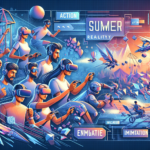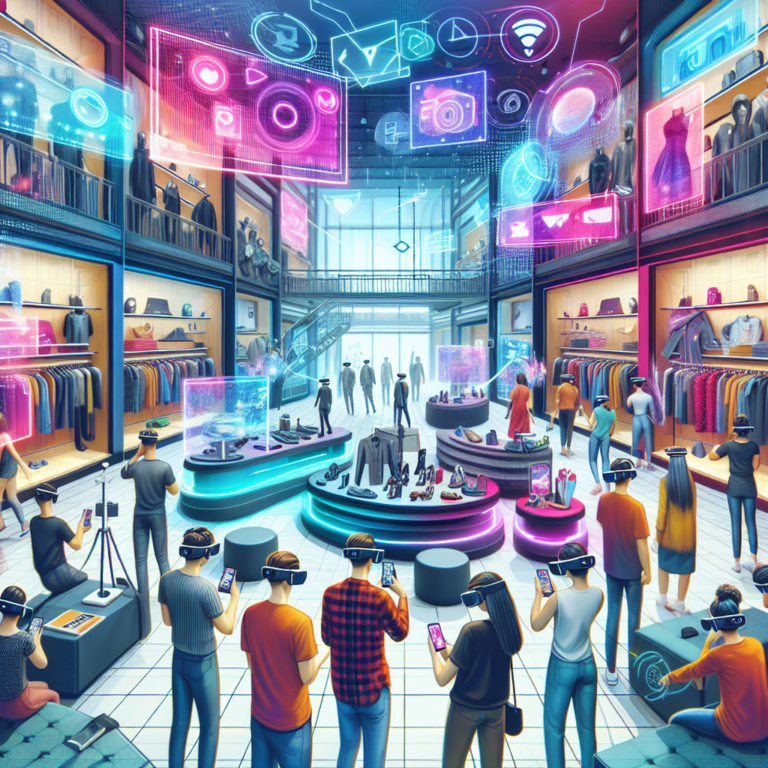The Future of Shopping: How AR and VR are Transforming the Retail Experience 🛍️
Understanding the World of AR and VR in Retail 🕶️
As technology evolves at breakneck speed, Augmented Reality (AR) and Virtual Reality (VR) are making significant inroads into the retail sector. But what exactly are these technologies?
- AR: Augmented Reality overlays digital information, such as images and animations, onto the real world through devices like smartphones and tablets. Imagine trying on sunglasses virtually—this is AR bridging the gap between online shopping and in-store experiences!
- VR: On the other hand, Immersive Virtual Reality transports users into a completely digital realm, often through headsets like the HTC Vive. You’re not just looking at products; you’re experiencing an entirely new world.
Enhancing Traditional Retail with AR and VR 🎉
The typical shopping experience has transformed dramatically, thanks in large part to immersive technologies. Retailers are leveraging AR and VR to enhance customer engagement in ways previously unimagined. Here are some game-changing applications:
- Virtual Try-Ons: Customers can now see how clothing or accessories will look on them without ever stepping into a fitting room. This not only saves time but also boosts confidence in their purchases.
- Product Customization: Shoppers can modify colors, materials, and other features of a product, allowing for a personalized shopping experience that was once limited to high-end boutiques.
- 3D Product Visualization: With high-resolution 3D images, customers get a detailed view of what they are purchasing, ensuring they know exactly what to expect.
The Rise of Immersive Retail 🌐
Immersive retail merges the digital with the physical to create memorable shopping experiences. This blending of environments isn’t just about aesthetics; it’s about deepening customer interaction:
- XR (Extended Reality): This term encompasses both AR and VR, providing maximum engagement through interactive content that can be experienced in real-time.
- Interactive In-Store Displays: Imagine walking into a store and seeing a digital display that responds to your presence, offering personalized recommendations!
Practical Applications: AR and VR in Retail 🏬
Many leading retailers are already reaping the rewards of innovative AR and VR implementations. Here are some inspiring case studies:
- Virtual Fitting Rooms: Brands like L’Oreal use AR filters to allow users to try out different shades of makeup virtually.
- Decor Visualizers: Wayfair has developed an app where you can visualize furniture in your actual living space before making a purchase.
- VR Shopping Events: Brands are starting to use custom VR environments for special releases, creating a buzz that traditional shopping methods simply can’t achieve.
The Benefits of Embracing AR and VR 💡
Investing in AR and VR isn’t just a trend; it’s a strategic move with proven benefits once thought exclusive to tech-savvy companies:
- Higher Conversion Rates: When customers can engage with products in a more immersive way, they are more likely to make a purchase.
- Reduced Return Rates: By allowing customers to visualize exactly what they are buying, retailers can significantly decrease the likelihood of returns.
- Enhancing Customer Engagement: AR and VR provide experiences that stick with customers, fostering brand loyalty and encouraging repeat visits.
- Global Reach: With online AR experiences available on multiple devices, retailers can connect with a wider audience.
Challenges to Consider ⚠️
While the prospects of AR and VR are promising, there are challenges retailers must navigate:
- Initial Investment Costs: Building AR and VR platforms requires significant upfront investment in hardware and software.
- User Experience Continuity: It’s crucial to provide a seamless journey from online to offline experiences to avoid customer frustration.
- Data Privacy Concerns: With new technologies come new regulations. Retailers must ensure they remain compliant while implementing AR/VR experiences.
- Customer Education: As with any new technology, there’s a learning curve. Retailers must engage customers to educate them about the benefits.
Future Trends: What Lies Ahead? 🔮
The evolving landscape of retail technology holds exciting possibilities. Let’s explore what the future might bring:
- AI Integration: Expect AI-driven platforms to personalize experiences further and streamline shopping journeys.
- Wearable AR Devices: Imagine wearing AR glasses that help navigate stores by highlighting products and instant deals.
- Virtual Shopping Malls: The idea of browsing a mall from your living room is becoming less distant with advancements in XR technology.
- Mixed Reality Experiences: The marrying of digital and physical elements will create retail experiences that feel truly unique and dynamic.
The Impact of AR and VR on Retail 🌍
The infusion of AR and VR into retail networks is proving transformative. Customers are craving interactive experiences, and brands that can deliver will undoubtedly thrive. Early adoption is essential as competition heats up, and those who can creatively incorporate these technologies into their marketing strategies will stand out.
As the retail landscape continues to reshape itself through immersive experiences, savvy brands will leverage the power of AR and VR to establish stronger connections with their customers, build loyalty, and ultimately drive success.




0 Comments